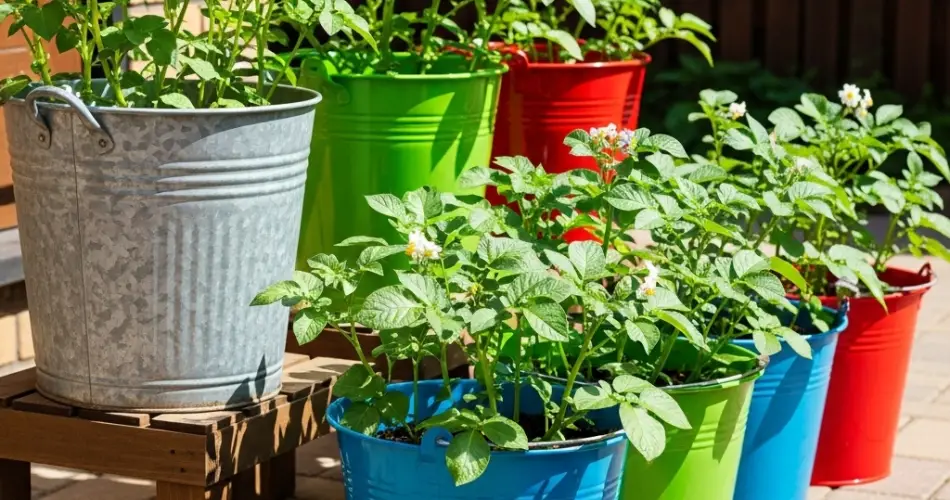Potatoes are a versatile and nutritious vegetable that can be successfully grown in small spaces using bucket gardening. Ideal for balconies, patios, and small urban gardens, container-grown potatoes allow you to enjoy a fresh harvest without a traditional garden bed. With the right containers, soil, and care techniques, you can cultivate healthy plants and enjoy homegrown potatoes all season long.
Selecting the Right Bucket
The first step in container potato gardening is choosing an appropriate bucket. Since potatoes develop tubers underground, a bucket with a depth of at least 12–16 inches is necessary. Larger containers provide more space for multiple plants and better soil moisture retention, supporting abundant tuber growth.
Ensure the bucket has drainage holes to prevent waterlogging, which can lead to root rot and reduce yields. Lightweight plastic buckets are easy to move to maximize sunlight exposure, while terracotta or ceramic containers retain moisture effectively but may require more frequent watering in hot weather.
Preparing Soil for Potatoes
Potatoes thrive in loose, fertile, and well-draining soil. A high-quality potting mix enriched with compost or organic matter provides essential nutrients while maintaining adequate moisture. Avoid heavy or compacted soils, which can hinder tuber formation and result in misshapen potatoes.
Adding perlite or coarse sand improves aeration and prevents soil compaction, promoting healthy root and tuber development. Potatoes prefer slightly acidic to neutral soil with a pH between 5.5 and 7.0. Fill the bucket about an inch below the rim to allow room for watering and mulching.
Mulching with straw or shredded leaves helps retain soil moisture, regulates soil temperature, and reduces weed growth, creating optimal conditions for potato plants.
Choosing Potato Varieties
Several potato varieties perform well in container gardening. Early-maturing types, such as ‘Yukon Gold,’ ‘Red Pontiac,’ and ‘Charlotte,’ are ideal for buckets because they produce smaller, uniform tubers suitable for limited spaces. Selecting the right variety ensures a productive harvest and reduces the risk of overcrowding in containers.
Planting Potatoes in Buckets
Potatoes are typically grown from seed potatoes—small tubers or pieces of larger tubers with at least one or two “eyes.” Cut larger seed potatoes into sections with at least one eye each, and allow them to dry for a day or two to prevent rot.
Place the seed potatoes in the bottom of the container, about 3–4 inches deep, with the eyes facing upward. Cover with 3–4 inches of soil. As the plants grow, gradually add more soil or mulch around the stems to cover emerging tubers, a process known as “hilling,” which encourages larger yields.
Watering and Moisture Management
Consistent moisture is key to successful potato growth. The soil should remain evenly moist but not soggy. Overwatering can cause rot, while under-watering may reduce tuber size and affect flavor.
Water in the morning to allow the foliage to dry during the day, reducing the risk of fungal diseases. Mulching helps maintain soil moisture, keeps the roots cool, and minimizes the frequency of watering.
Sunlight Requirements
Potatoes require full sunlight to grow optimally, ideally 6–8 hours per day. Position buckets in a bright, sunny location on a balcony or patio. Adequate sunlight ensures strong foliage, robust tuber development, and improved overall plant health.
Fertilization and Care
Potatoes are moderate feeders and benefit from nutrient-rich soil. Incorporate compost or a balanced, slow-release fertilizer into the soil before planting to support healthy growth. Avoid excessive nitrogen, which can promote leafy growth at the expense of tuber production.
Remove yellowing or damaged leaves to improve airflow and reduce disease risk. Proper care ensures that container-grown potatoes remain productive throughout the growing season.
Harvesting Potatoes
Early potatoes can be harvested when plants begin to flower, typically 60–80 days after planting, depending on the variety. For main crop potatoes, wait until the foliage starts to yellow and die back. Gently dig through the soil to remove tubers, taking care not to damage the surrounding roots.
For a continuous harvest, stagger plantings or grow a mix of early and mid-season varieties in separate containers. This method ensures a steady supply of fresh, homegrown potatoes.
Benefits of Bucket Potato Gardening
Growing potatoes in buckets offers numerous advantages for small-space gardeners. Containers provide control over soil, water, and sunlight, reduce exposure to pests and soil-borne diseases, and make gardening feasible in urban environments. With proper care, container-grown potatoes yield fresh, nutritious tubers without requiring a traditional garden bed.
By selecting the right container, preparing fertile and well-draining soil, maintaining consistent watering and sunlight, and following proper planting and harvesting techniques, gardeners can enjoy a bountiful potato harvest in small spaces. Bucket gardening transforms balconies and patios into productive vegetable gardens, offering fresh, homegrown potatoes year-round.



